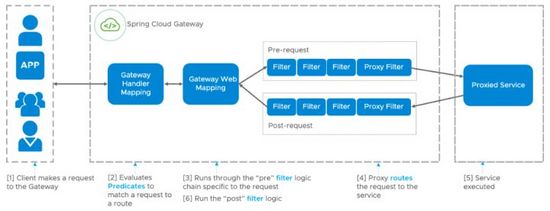在本文中,我们着眼于为 Spring Cloud Gateway 编写自定义扩展。在开始之前,让我们回顾一下 Spring Cloud Gateway 的工作原理:

?
- 首先,客户端向网关发出网络请求
- 网关定义了许多路由,每个路由都有谓词来匹配请求和路由。例如,您可以匹配 URL 的路径段或请求的 HTTP 方法。
- 一旦匹配,网关对应用于路由的每个过滤器执行预请求逻辑。例如,您可能希望将查询参数添加到您的请求中
- 代理过滤器将请求路由到代理服务
- 服务执行并返回响应
- 网关接收响应并在返回响应之前对每个过滤器执行请求后逻辑。例如,您可以在返回客户端之前删除不需要的响应标头。
我们的扩展将对请求正文进行哈希处理,并将该值添加为名为 的请求标头X-Hash。这对应于上图中的步骤 3。注意:当我们读取请求正文时,网关将受到内存限制。
首先,我们在?start.spring.io?中创建一个具有 Gateway 依赖项的项目。在此示例中,我们将在 Java 中使用带有 JDK 17 和 Spring Boot 2.7.3 的 Gradle 项目。下载、解压缩并在您喜欢的 IDE 中打开项目并运行它,以确保您已为本地开发做好准备。
接下来让我们创建 GatewayFilter Factory,它是一个限定于特定路由的过滤器,它允许我们以某种方式修改传入的 HTTP 请求或传出的 HTTP 响应。在我们的例子中,我们将使用附加标头修改传入的 HTTP 请求:
<b>package</b> com.example.demo;
<b>import</b> java.security.MessageDigest;
<b>import</b> java.security.NoSuchAlgorithmException;
<b>import</b> java.util.Collections;
<b>import</b> java.util.List;
<b>import</b> org.bouncycastle.util.encoders.Hex;
<b>import</b> reactor.core.publisher.Mono;
<b>import</b> org.springframework.cloud.gateway.filter.GatewayFilter;
<b>import</b> org.springframework.cloud.gateway.filter.factory.AbstractGatewayFilterFactory;
<b>import</b> org.springframework.cloud.gateway.support.ServerWebExchangeUtils;
<b>import</b> org.springframework.http.codec.HttpMessageReader;
<b>import</b> org.springframework.http.server.reactive.ServerHttpRequest;
<b>import</b> org.springframework.stereotype.Component;
<b>import</b> org.springframework.util.Assert;
<b>import</b> org.springframework.web.reactive.function.server.HandlerStrategies;
<b>import</b> org.springframework.web.reactive.function.server.ServerRequest;
<b>import</b> <b>static</b> org.springframework.cloud.gateway.support.ServerWebExchangeUtils.CACHED_SERVER_HTTP_REQUEST_DECORATOR_ATTR;
<font><i>/**
* This filter hashes the request body, placing the value in the X-Hash header.
* Note: This causes the gateway to be memory constrained.
* Sample usage: RequestHashing=SHA-256
*/</i></font><font>
@Component
<b>public</b> <b>class</b> RequestHashingGatewayFilterFactory <b>extends</b>
AbstractGatewayFilterFactory<RequestHashingGatewayFilterFactory.Config> {
<b>private</b> <b>static</b> <b>final</b> String HASH_ATTR = </font><font>"hash"</font><font>;
<b>private</b> <b>static</b> <b>final</b> String HASH_HEADER = </font><font>"X-Hash"</font><font>;
<b>private</b> <b>final</b> List<HttpMessageReader<?>> messageReaders =
HandlerStrategies.withDefaults().messageReaders();
<b>public</b> RequestHashingGatewayFilterFactory() {
<b>super</b>(Config.<b>class</b>);
}
@Override
<b>public</b> GatewayFilter apply(Config config) {
MessageDigest digest = config.getMessageDigest();
<b>return</b> (exchange, chain) -> ServerWebExchangeUtils
.cacheRequestBodyAndRequest(exchange, (httpRequest) -> ServerRequest
.create(exchange.mutate().request(httpRequest).build(),
messageReaders)
.bodyToMono(String.<b>class</b>)
.doOnNext(requestPayload -> exchange
.getAttributes()
.put(HASH_ATTR, computeHash(digest, requestPayload)))
.then(Mono.defer(() -> {
ServerHttpRequest cachedRequest = exchange.getAttribute(
CACHED_SERVER_HTTP_REQUEST_DECORATOR_ATTR);
Assert.notNull(cachedRequest,
</font><font>"cache request shouldn't be null"</font><font>);
exchange.getAttributes()
.remove(CACHED_SERVER_HTTP_REQUEST_DECORATOR_ATTR);
String hash = exchange.getAttribute(HASH_ATTR);
cachedRequest = cachedRequest.mutate()
.header(HASH_HEADER, hash)
.build();
<b>return</b> chain.filter(exchange.mutate()
.request(cachedRequest)
.build());
})));
}
@Override
<b>public</b> List<String> shortcutFieldOrder() {
<b>return</b> Collections.singletonList(</font><font>"algorithm"</font><font>);
}
<b>private</b> String computeHash(MessageDigest messageDigest, String requestPayload) {
<b>return</b> Hex.toHexString(messageDigest.digest(requestPayload.getBytes()));
}
<b>static</b> <b>class</b> Config {
<b>private</b> MessageDigest messageDigest;
<b>public</b> MessageDigest getMessageDigest() {
<b>return</b> messageDigest;
}
<b>public</b> <b>void</b> setAlgorithm(String algorithm) throws NoSuchAlgorithmException {
messageDigest = MessageDigest.getInstance(algorithm);
}
}
}
</font>
让我们更详细地看一下代码:
- 我们为该类添加了@Component注解。Spring Cloud Gateway需要能够检测到这个类,以便使用它。另外,我们也可以用@Bean定义一个实例。
- 在我们的类名中,我们使用GatewayFilterFactory作为后缀。在application.yaml中添加这个过滤器时,我们不包括后缀,只包括RequestHashing。这是一个Spring Cloud Gateway过滤器的命名惯例。
- 我们的类还扩展了AbstractGatewayFilterFactory,与所有其他Spring Cloud Gateway过滤器类似。我们还指定了一个类来配置我们的过滤器,一个名为Config的嵌套静态类有助于保持简单。这个配置类允许我们设置使用哪种散列算法。
- 重载的apply方法是所有工作发生的地方。在参数中,我们得到了一个配置类的实例,在那里我们可以访问MessageDigest实例进行散列。接下来,我们看到(exchange, chain),一个GatewayFilter接口类的lambda被返回。Exchange是ServerWebExchange的一个实例,为Gateway过滤器提供对HTTP请求和响应的访问。对于我们的案例,我们想修改HTTP请求,这就要求我们对交换进行变异。
- 我们需要读取请求体来产生哈希值,然而,由于请求体被存储在一个字节缓冲区中,它在过滤器中只能被读取一次。通过使用ServerWebExchangeUtils,我们把请求作为交换中的一个属性进行缓存。属性提供了一种在过滤器链中共享特定请求数据的方式。我们也将存储请求主体的计算哈希值。
- 我们使用交换的属性来获取缓存的请求和计算的哈希值。然后我们通过添加哈希头来突变交换,最后将其发送到链上的下一个过滤器。
- shortcutFieldOrder方法有助于将参数的数量和顺序映射到过滤器中。该算法字符串与配置类中的setter相匹配。
为了测试代码,我们将使用 WireMock。将依赖项添加到您的build.gradle文件中:
testImplementation 'com.github.tomakehurst:wiremock:2.27.2'
在这里,我们有一个测试检查头的存在和价值,如果没有请求正 ,文另一个测试检查头是否不存在。
<b>package</b> com.example.demo;
<b>import</b> java.security.MessageDigest;
<b>import</b> java.security.NoSuchAlgorithmException;
<b>import</b> com.github.tomakehurst.wiremock.WireMockServer;
<b>import</b> com.github.tomakehurst.wiremock.client.WireMock;
<b>import</b> com.github.tomakehurst.wiremock.core.WireMockConfiguration;
<b>import</b> org.bouncycastle.jcajce.provider.digest.SHA512;
<b>import</b> org.bouncycastle.util.encoders.Hex;
<b>import</b> org.junit.jupiter.api.AfterEach;
<b>import</b> org.junit.jupiter.api.Test;
<b>import</b> org.springframework.beans.factory.annotation.Autowired;
<b>import</b> org.springframework.boot.test.autoconfigure.web.reactive.AutoConfigureWebTestClient;
<b>import</b> org.springframework.boot.test.context.SpringBootTest;
<b>import</b> org.springframework.boot.test.context.TestConfiguration;
<b>import</b> org.springframework.cloud.gateway.filter.GatewayFilter;
<b>import</b> org.springframework.cloud.gateway.route.RouteLocator;
<b>import</b> org.springframework.cloud.gateway.route.builder.RouteLocatorBuilder;
<b>import</b> org.springframework.context.annotation.Bean;
<b>import</b> org.springframework.http.HttpStatus;
<b>import</b> org.springframework.test.web.reactive.server.WebTestClient;
<b>import</b> <b>static</b> com.example.demo.RequestHashingGatewayFilterFactory.*;
<b>import</b> <b>static</b> com.example.demo.RequestHashingGatewayFilterFactoryTest.*;
<b>import</b> <b>static</b> com.github.tomakehurst.wiremock.client.WireMock.equalTo;
<b>import</b> <b>static</b> com.github.tomakehurst.wiremock.client.WireMock.postRequestedFor;
<b>import</b> <b>static</b> com.github.tomakehurst.wiremock.client.WireMock.urlEqualTo;
<b>import</b> <b>static</b> com.github.tomakehurst.wiremock.core.WireMockConfiguration.wireMockConfig;
<b>import</b> <b>static</b> org.springframework.boot.test.context.SpringBootTest.WebEnvironment.RANDOM_PORT;
@SpringBootTest(
webEnvironment = RANDOM_PORT,
<b>class</b>es = RequestHashingFilterTestConfig.<b>class</b>)
@AutoConfigureWebTestClient
<b>class</b> RequestHashingGatewayFilterFactoryTest {
@TestConfiguration
<b>static</b> <b>class</b> RequestHashingFilterTestConfig {
@Autowired
RequestHashingGatewayFilterFactory requestHashingGatewayFilter;
@Bean(destroyMethod = <font>"stop"</font><font>)
WireMockServer wireMockServer() {
WireMockConfiguration options = wireMockConfig().dynamicPort();
WireMockServer wireMock = <b>new</b> WireMockServer(options);
wireMock.start();
<b>return</b> wireMock;
}
@Bean
RouteLocator testRoutes(RouteLocatorBuilder builder, WireMockServer wireMock)
throws NoSuchAlgorithmException {
Config config = <b>new</b> Config();
config.setAlgorithm(</font><font>"SHA-512"</font><font>);
GatewayFilter gatewayFilter = requestHashingGatewayFilter.apply(config);
<b>return</b> builder
.routes()
.route(predicateSpec -> predicateSpec
.path(</font><font>"/post"</font><font>)
.filters(spec -> spec.filter(gatewayFilter))
.uri(wireMock.baseUrl()))
.build();
}
}
@Autowired
WebTestClient webTestClient;
@Autowired
WireMockServer wireMockServer;
@AfterEach
<b>void</b> afterEach() {
wireMockServer.resetAll();
}
@Test
<b>void</b> shouldAddHeaderWithComputedHash() {
MessageDigest messageDigest = <b>new</b> SHA512.Digest();
String body = </font><font>"hello world"</font><font>;
String expectedHash = Hex.toHexString(messageDigest.digest(body.getBytes()));
wireMockServer.stubFor(WireMock.post(</font><font>"/post"</font><font>).willReturn(WireMock.ok()));
webTestClient.post().uri(</font><font>"/post"</font><font>)
.bodyValue(body)
.exchange()
.expectStatus()
.isEqualTo(HttpStatus.OK);
wireMockServer.verify(postRequestedFor(urlEqualTo(</font><font>"/post"</font><font>))
.withHeader(</font><font>"X-Hash"</font><font>, equalTo(expectedHash)));
}
@Test
<b>void</b> shouldNotAddHeaderIfNoBody() {
wireMockServer.stubFor(WireMock.post(</font><font>"/post"</font><font>).willReturn(WireMock.ok()));
webTestClient.post().uri(</font><font>"/post"</font><font>)
.exchange()
.expectStatus()
.isEqualTo(HttpStatus.OK);
wireMockServer.verify(postRequestedFor(urlEqualTo(</font><font>"/post"</font><font>))
.withoutHeader(</font><font>"X-Hash"</font><font>));
}
}
</font>
为了在我们的网关中使用该过滤器,我们在application.yaml的路由中添加RequestHashing过滤器,使用SHA-256作为算法。
spring:
cloud:
gateway:
routes:
- id: demo
uri: https:<font><i>//httpbin.org</i></font><font>
predicates:
- Path=/post</font><font><i>/**
filters:
- RequestHashing=SHA-256
</i></font>
我们使用https://httpbin.org,因为它在其返回的响应中显示了我们的请求头信息。运行应用程序,并进行curl请求以查看结果。
$> curl --request POST 'http://localhost:8080/post' \
--header 'Content-Type: application/json' \
--data-raw '{
"data": {
"hello": "world"
}
}'
{
...
"data": "{\n \"data\": {\n \"hello\": \"world\"\n }\n}",
"headers": {
"Accept": "*/*",
"Accept-Encoding": "gzip, deflate, br",
"Content-Length": "48",
"Content-Type": "application/json",
"Forwarded": "proto=http;host=\"localhost:8080\"for=\"[0:0:0:0:0:0:0:1]:55647\"",
"Host": "httpbin.org",
"User-Agent": "PostmanRuntime/7.29.0",
"X-Forwarded-Host": "localhost:8080",
"X-Hash": "1bd93d38735501b5aec7a822f8bc8136d9f1f71a30c2020511bdd5df379772b8"
},
...
}
综上所述,我们看到了如何为Spring Cloud Gateway编写一个自定义扩展。我们的过滤器读取了请求的主体,产生了一个哈希值,我们将其作为请求头添加。我们还使用WireMock为该过滤器编写了测试,以检查头的值。最后,我们用该过滤器运行了一个网关来验证结果。
如果你打算在Kubernetes集群上部署Spring Cloud Gateway,一定要查看VMware Spring Cloud Gateway for Kubernetes。除了支持开源的Spring Cloud Gateway过滤器和自定义过滤器(比如我们上面写的那个),它还配有更多的内置过滤器来处理你的请求和响应。Spring Cloud Gateway for Kubernetes代表API开发团队处理跨领域的问题,例如。单点登录(SSO)、访问控制、速率限制、弹性、安全等等。
?